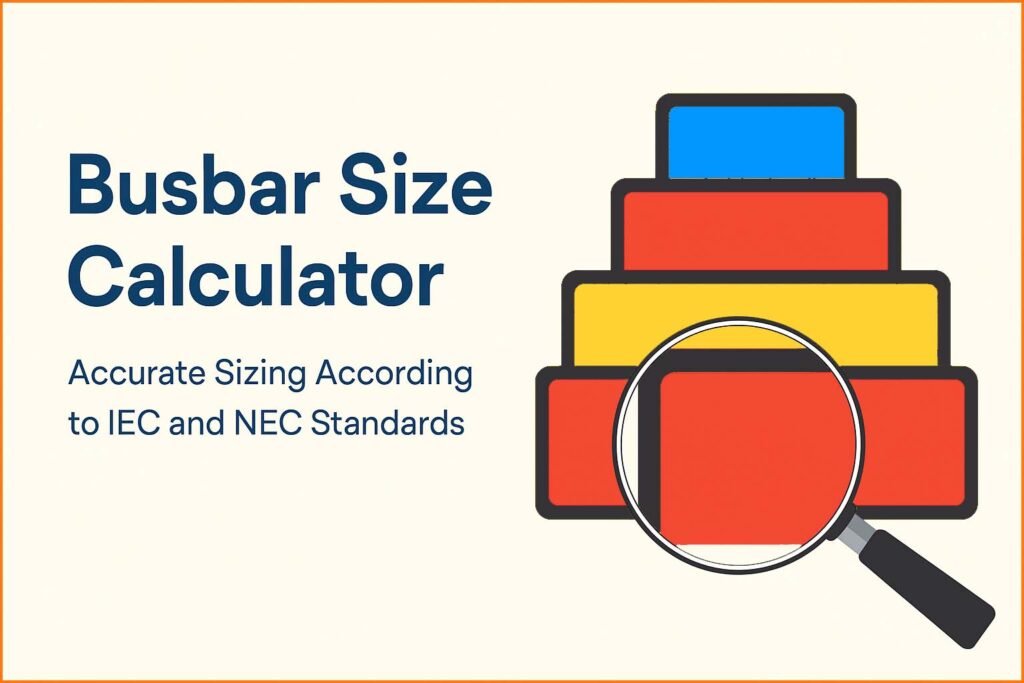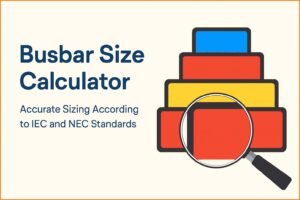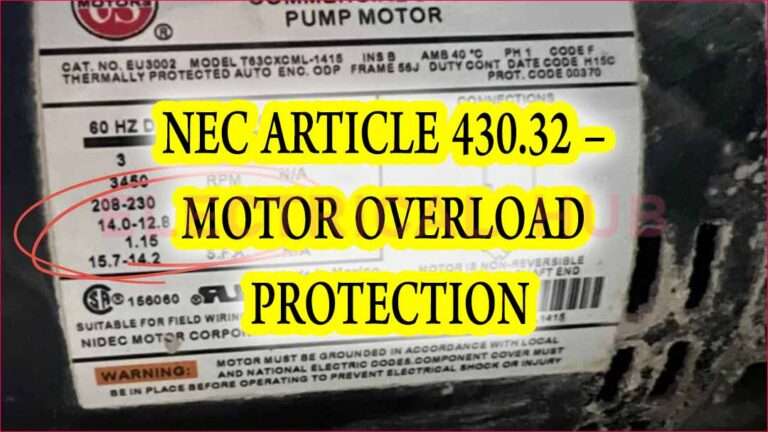Busbar Size Calculator – Accurate Sizing According to IEC and NEC Standards
Busbar sizing is a critical part of electrical system design. Choosing the correct size ensures efficiency, safety, and long-term reliability of power distribution. The Busbar Size Calculator helps engineers and electricians find the right copper or aluminum busbar dimensions based on current capacity, material type, and environmental conditions. This article explains how the calculator works, the standards it follows (IEC and NEC), and what factors influence the final busbar size.

Table of Contents
What Is a Busbar and Why Its Size Matters
A busbar is a metallic strip or bar used to conduct electricity within switchboards, distribution panels, or substations. It acts as a common junction for electrical currents. The correct sizing of a busbar determines how efficiently it can carry current without overheating or causing excessive voltage drop. If undersized, a busbar can lead to dangerous temperature rise, equipment failure, or energy losses. Oversizing, on the other hand, increases cost and space requirements.
A Busbar Size Calculator simplifies this task by automatically determining the required cross-sectional area and dimensions according to international standards like IEC 61439 and NEC 366.
Understanding the Busbar Size Calculator
The Busbar Size Calculator is a practical online tool that calculates the optimal busbar size for copper or aluminum conductors. You only need to input the following parameters:
- System voltage (V)
- Maximum load current (A)
- Busbar material (Copper or Aluminum)
- Ambient temperature (°C)
- Permissible temperature rise (°C)
- Number of busbars per phase
Based on these inputs, the calculator provides the ideal width, thickness, and cross-sectional area that can safely carry the current as per IEC or NEC guidelines.
Use our online tool Street Light Voltage Drop Calculator – Accurate Cable Sizing & Power Loss Estimation Tool
The calculator uses predefined current density values to maintain safe operation. For example:
- Copper: 1.2 to 1.6 A/mm² for natural cooling
- Aluminum: 0.8 to 1.2 A/mm² for natural cooling
These values are adjusted according to installation type, ventilation, and temperature rise limits.
Busbar Size Calculator (IEC & NEC Compliant)
Determine the appropriate busbar size based on current, material, temperature rise, and fault level.
Busbar Sizing According to IEC Standards
The International Electrotechnical Commission (IEC) provides globally accepted guidelines for electrical installations. According to IEC 61439-1, the current-carrying capacity of busbars depends on:
- Material conductivity
- Cross-sectional area
- Ambient temperature
- Type of insulation and enclosure
- Cooling conditions
In IEC standards, current density is used to estimate the required busbar size. The formula used in most cases is:
Current Density (A/mm²) = Current (A) ÷ Cross-Sectional Area (mm²)
For copper busbars, the IEC recommends keeping current density around 1.2 to 1.6 A/mm² under normal air-cooled conditions. For aluminum, the range is 0.8 to 1.2 A/mm².
The Busbar Size Calculator applies these values automatically, ensuring the design complies with IEC safety margins.
Example (IEC Based Calculation)
| Parameter | Value |
|---|---|
| Material | Copper |
| Load Current | 1000 A |
| Current Density | 1.5 A/mm² |
| Required Area | 1000 ÷ 1.5 = 667 mm² |
If a single bar of 100 mm width is used, the thickness should be approximately 6.7 mm. The calculator gives this instantly, ensuring compliance with IEC rules.
Use our online tool Transformer Efficiency Calculator – Calculate Power, Losses & Performance Instantly
Busbar Sizing According to NEC Standards
The National Electrical Code (NEC), primarily used in North America, defines ampacity tables for conductors including busbars. The NEC considers conductor temperature ratings (60°C, 75°C, or 90°C), ambient temperature, and derating factors.
In NEC-based systems, ampacity is derived from standard tables or empirical data. The Busbar Size Calculator simplifies this by referencing NEC ampacity limits for copper and aluminum conductors. It then matches your input current to the nearest safe cross-sectional size.
Typical NEC-based current capacities for bare busbars:
| Material | Temperature Rise | Current Density (A/mm²) |
|---|---|---|
| Copper | 50°C | 1.2 |
| Copper | 65°C | 1.6 |
| Aluminum | 50°C | 0.8 |
| Aluminum | 65°C | 1.1 |
The calculator adjusts automatically for parallel bars and derating factors due to enclosure or spacing.
Example (NEC Based Calculation)
| Parameter | Value |
|---|---|
| Material | Aluminum |
| Load Current | 1200 A |
| Current Density | 1.0 A/mm² |
| Required Area | 1200 mm² |
If you use 2 bars per phase, each must be 600 mm², which could be a 100 mm × 6 mm aluminum bar.
Copper vs Aluminum Busbars
Your Busbar Size Calculator also lets you choose between copper and aluminum materials. Both have advantages, but they differ in conductivity and cost.
| Property | Copper | Aluminum |
|---|---|---|
| Conductivity | 100% | 61% of copper |
| Current Density | 1.2–1.6 A/mm² | 0.8–1.2 A/mm² |
| Weight | Heavier | Lighter |
| Cost | Higher | Lower |
| Oxidation Resistance | Excellent | Needs coating |
Copper is preferred in compact panels or high-current applications, while aluminum is more economical in large bus duct systems. The calculator provides dimensions for both, allowing cost-performance comparison.
Use our online tool Cable Bending Radius Calculator – Accurate Minimum Bend Radius for Electrical Cables
Factors Affecting Busbar Size
Several real-world conditions affect busbar performance. The Busbar Size Calculator accounts for these factors:
- Ambient Temperature: Higher ambient temperature reduces current-carrying capacity. The calculator derates current accordingly.
- Cooling Method: Natural air-cooled or forced air systems affect heat dissipation.
- Installation Orientation: Horizontal or vertical mounting changes the heat transfer path.
- Enclosure Type: Enclosed systems heat up faster, requiring larger busbars.
- Parallel Busbars: When more than one bar is used per phase, current sharing must be even. The calculator divides total current equally among bars.
How the Busbar Size Calculator Helps Engineers
The Busbar Size Calculator reduces design time and human error. It delivers accurate sizing results within seconds and follows both IEC and NEC methodologies. This ensures global applicability, whether you’re designing a panel for Europe, the Middle East, or North America.
It also optimizes material use. Oversized busbars increase cost unnecessarily, while undersized bars risk overheating. By finding the perfect balance, the calculator improves safety, cost-efficiency, and compliance.
Use our online tool Differential Amplifier Calculator – Calculate Gain & Output Voltage Easily
Recommended Current Density Values
Here’s a quick reference table often used by engineers and integrated into the Busbar Size Calculator:
| Material | Cooling Type | Typical Current Density (A/mm²) |
|---|---|---|
| Copper | Natural Air Cooling | 1.2–1.6 |
| Copper | Forced Air Cooling | 1.8–2.5 |
| Aluminum | Natural Air Cooling | 0.8–1.2 |
| Aluminum | Forced Air Cooling | 1.4–1.8 |
These values are adjusted automatically based on user input for ambient conditions and permissible temperature rise.
Practical Example Using the Busbar Size Calculator
Imagine a 1600 A distribution board made with copper busbars in an ambient temperature of 40°C. Assuming natural cooling and 1.5 A/mm² current density:
Required Area = 1600 ÷ 1.5 = 1067 mm²
If two bars per phase are used, each bar should have 533 mm² cross-section, which corresponds to approximately 100 mm × 5.3 mm bars.
The calculator would instantly show this configuration, along with an alert if the temperature rise exceeds safe limits.
Advantages of Using a Busbar Size Calculator
- Saves time in manual calculations
- Ensures compliance with IEC and NEC standards
- Reduces risk of overheating or voltage drop
- Provides accurate sizing for both copper and aluminum
- Optimizes cost and material usage
- Suitable for LV and MV distribution panels, switchboards, and bus ducts
Use our online tool Sub Panel Wire Size Calculator – Accurate Wire Gauge & Load Sizing Tool
Conclusion
The Busbar Size Calculator is an essential engineering tool that combines accuracy, safety, and efficiency. Whether you follow IEC or NEC standards, it instantly provides the correct busbar dimensions for copper or aluminum conductors based on your system’s load and environmental factors.
By using this calculator, electrical engineers can ensure compliance, improve design reliability, and save time in the sizing process. For any power distribution project, starting with the right busbar size is key to achieving safe and efficient operation.
The next time you design a switchboard or substation, use the Busbar Size Calculator to find the most reliable and cost-effective configuration that meets international standards.
Follow Us on Social:
Subscribe our Newsletter on Electrical Insights to get the latest updates in Electrical Engineering.
#BusbarSizeCalculator, #BusbarSizing, #ElectricalDesign, #IECStandards, #NECStandards, #CopperBusbar, #AluminumBusbar, #ElectricalEngineering, #BusbarCalculation, #ElectricalSafety, #PanelDesign, #SwitchgearDesign, #PowerDistribution, #CurrentCarryingCapacity, #ElectricalTools
Busbar Size Calculator – Accurate Sizing According to IEC and NEC Standards : Electrical Engineering Hub

Use our Busbar Size Calculator to find accurate copper and aluminum busbar sizes according to IEC and NEC standards. Optimize your electrical panel design with precise current-carrying capacity, material selection, and safety compliance
Price Currency: USD
Operating System: All
Application Category: UtilitiesApplication





